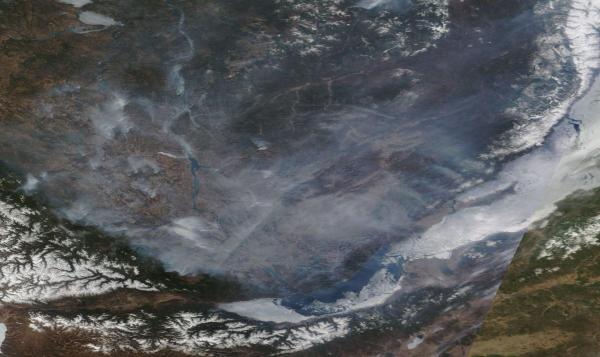(NASA LANCE MODIS Rapid Fire hotspot analysis of extreme fire outbreak in the Amur region of Russia on April 28, 2014. In this shot, the Amur runs west to east through the frame. To the right is the Pacific Ocean [off frame] to the left is a corner of Russia’s massive Lake Baikal. The red spots indicate currently active fires. Image source: LANCE-MODIS)
What we are currently witnessing is something that should never happen — an outbreak of fires with summer intensity during late April at a time when Siberia should still be frigid and frozen.
* * * * *
Last year, during late July and early August, a series of epic wildfires raged to the north and west of Russia’s far eastern Amur region. About a week later, the skies opened up in a ten-day-long deluge that pushed the Amur River bordering Russia and China to levels not seen in the entire 150 year span of record-keeping for the region. Whole cities were submerged as the Amur leapt its banks to form a kind of massive inland sea.
The floods promoted strong growth in the region, penetrating permafrost zones to enhance melt, providing major fuel sources for fires should they re-emerge. Come winter, a persistent warm ridge pattern in the Jet Stream transported hotter than usual air over this region. The winter was far, far warmer than it should have been. And when spring came, it came like the onset of summer.
Last week, temperatures soared into the 70s and ever since the beginning of April, freakishly large fires for so early in the burn season erupted. By April 23rd, the Russian fire ministry had logged nearly 3,000 fires. The outbreak was so intense that, just a few days ago, more than 5,000 pieces of heavy equipment and an army of firefighters were engaged throughout a large stretch of Russia from the still frozen shores of Lake Baikal to the far eastern Amur region.
But last night’s LANCE-MODIS satellite pass brought with it unexpected new horrors:
(Two massive wildfires in excess of 200 square miles burning in the Amur region of Russia on April 28, 2014. Image source: LANCE-MODIS.)
Two massive burn scars devouring huge sections of land in the Amur region of Russia.
For scale, the ribbon of blue traveling north to south beneath the first massive fire is a mile-wide tributary to the Amur river called the Zeya. Using the scale provided by LANCE MODIS, we see that the fire at upper left is currently about 15 x 18 miles (270 square miles) in area and that the fire at lower right is about 23 x 20 miles (460 square miles) in area.
Even during Russia’s recent global warming-spurred epic fire seasons of 2010 to 2013 fires of this scope and obvious visible intensity didn’t come up in the satellite imagery until the most intense periods of summer heating during late June through early August. Today, we have monster fires comparable to those which burned during Russia’s worst ever recorded fire seasons, at their height, burning next to snow covered regions in late April.
As a last reference, look at the ice covered river in the far lower right corner of the above image. That swatch of crystalline white — yes, it’s a large estuary apparently being dwarfed by the massive fire burning just above it. Beneath wide body of still frozen water is what appears to be a ‘small’ plume of smoke. It’s worth noting that this smoke plume issues from a recently burned region covering fully 15 square miles. By comparison, the fires above each cover areas comparable to Guam, half of Rhode Island, or the massive ice island recently broken off from the now doomed Pine Island Glacier (PIG) — B31.
Unfortunately, these massive fires aren’t the only blazes covering extraordinary swaths of Russian land during late April. Moving west to the shores of the still partly frozen Lake Baikal, we find numerous fires burning beneath a sea of smoke in the lowlands between two, still snow-capped highlands.
(Sea of Smoke and Fire north and west of Lake Baikal on April 28, 2014. Image source: LANCE-MODIS.)
The entire roughly 200 x 200 mile (40,000 square mile) region is covered by the steely gray smoke of previous and ongoing blazes. Peering down through the dense shroud, we see numerous thick smoke plumes issuing from still out of control fires. The freakish prematurity of these blazes is readily apparent in the visible ice still covering much of Lake Baikal and also in the snow still doggedly clinging to the nearby mountainous highlands.
A vicious combination of thawing permafrost, a rapid increase in average temperatures throughout Siberia and driven by human warming, and the vulnerability of the active soil layer and related vegetation to rapid drying appears to be turning this region into an ever more explosive fire trap. Risk of wildfire is dependent on both heat and fuel. But with the permafrost containing an almost inexhaustible layer of either drying peat or venting methane and with temperatures now rising at twice the already rapid global rate, the potential for burning in or near the violatile permafrost thaw zone may well be practically unlimited.
These extraordinary and anomalous conditions, combined with a very intense early season warming, what appears to be a persistent and developing heat dome over Eastern Russia and adjacent Arctic Siberia, a very rapidly receding snow line, and, potentially, an amplifying effect from an emerging El Nino in the Pacific, results in a very high continued risk for both extreme and record fires throughout the spring and summer of 2014.
Links:
Russia Experiences Great Burning
A Dangerous Dance of Frost and Flame
100 Fires Burn 12,000 Hectares in Russia
Doomed Pine Island Glacier Guam-Sized Iceberg into Southern Ocean
Hat tip to Colorado Bob










dtlange
/ April 28, 2014Thanks, Robert.
Even here in the Pacific Northwest on days on warm spring days, it feels and looks like July.
How do we get the main stream media to report these important truths? — and how to wake up the citizenry?
Keep up the good work.
David
LikeLike
robertscribbler
/ April 28, 2014I see a few glimmers — Chris Hayes is now providing excellent coverage of climate change (even if he is borrowing heavily without attribution from some of my previous work: https://robertscribbler.wordpress.com/2013/03/22/when-burning-is-no-longer-moral-a-call-for-fossil-fuel-abolition/).
And the Showtime ‘Years of Living Dangerously’ is spot on.
A few glimmers. But the MSM is still almost entirely asleep.
LikeLike
robertscribbler
/ April 28, 2014You guys will probably have some rather interesting weather this year. You’re directly under a developing ridge and potential heat dome as well.
In any case, I must say that I really appreciate your front line observations. Please send them in whenever you feel you’ve seen something out of the ordinary.
LikeLike
dtlange
/ April 29, 2014The ‘interesting’ weather will commence here i Portland on Wednesday and Thursday with highs in the upper 80″s.
Ps As I write the whole western sky is half dome of gauzy Mylar haze that is likely from the fires and dust storms in Siberia and China — plus whatever is added the atmosphere in the Northwest. Will post photos to my blog ASAP.
LikeLike
Jim Botsford
/ April 28, 2014And here on the other side of the dipole in Michigan it’s still very cool to cold on most days.
LikeLike
robertscribbler
/ April 28, 2014You can view the extreme dipole in real time here:
http://earth.nullschool.net/#current/wind/surface/level/overlay=temp/orthographic=-94.42,59.15,1024
LikeLike
dtlange
/ April 28, 2014Q: What are some good links for following the jet stream’s behavior in real time? (Whatever burns in Siberia and such places will effect my location.) (My decision makers seem to have blinders on.)
Thanks, David
LikeLike
robertscribbler
/ April 28, 2014I prefer the University of Washington History and Model Analysis:
http://www.atmos.washington.edu/~ovens/wxloop.cgi?npole_h250_wind+/-168//
LikeLike
dtlange
/ April 28, 2014Very good, thank you. The atmos.washington and the earth.nullschool links go together.
LikeLike
Colorado Bob
/ April 28, 2014Biggest sandstorm in 10 years hits northern Chinese city Dunhuang
Schools were closed and visibility was reduced to just 20 metres in places as the strongest sandstorm to strike the northern Chinese city of Dunhuang swept in.
The sandstorm hit the city, in Gansu province, at 1.40pm on Wednesday, bringing strong winds and a sudden drop in temperature, and continued to rage for hours, forcing many people to wear masks.
http://www.scmp.com/news/china/article/1495721/biggest-sandstorm-10-years-hits-northern-chinese-city-dunhuang
LikeLike
Colorado Bob
/ April 28, 2014Aqua/MODIS
2014/117
04/27/2014
07:30 UTC
Dust storm in Taklimakan Desert, Western China

LikeLike
robertscribbler
/ April 28, 2014Coincident with ongoing heat waves. We have this in April. Should the pattern remain we are in for a very brutal summer.
LikeLike
Colorado Bob
/ April 28, 2014An Aerial View of China’s Colossal Dust Storm
Northern China’s not unaccustomed to dust barrages triggered by Siberian weather fronts to the north. This one’s a bit different: It moved eastward across the country with incredible speed and power. Look how far the leading dust-wall had surged in these NASA satellite images, taken on Wednesday at 12:35 p.m. local time and then 2:20 p.m.:
http://www.theatlanticcities.com/arts-and-lifestyle/2014/04/china-being-eaten-colossal-dust-storm/8967/
LikeLike
robertscribbler
/ April 30, 2014MODIS shots of fires are now even more impressive than yesterday. The once in the previous hot shot analysis from yesterday appear to have combined into a 100 mile long fire front.
LikeLike
james cole
/ April 28, 2014What is the prognosis for the Amazon should this El Nino develop fully? Would be some kind of double punch if the Amazon basin went into drought and the already bad fire situation there went out of control. Once rain forest is taken down, relative humidity in the area goes down and, as local fire fighters point out, fires that used to go out on their own now continue to burn on, compounding a sort of local feedback loop. Not sure what the local effects are of burned tiga and boreal forest are. I do know that in burned areas of our Northern Minnesota wilderness, the areas have a lot of ground heating in summer, as compared to the still forested areas. Sort of little heat islands, you can feel the dry heat as you canoe through a burned area. As compared to the humid warmth of the deep forest.
LikeLike
robertscribbler
/ April 28, 2014The Amazon hasn’t spooled out quite as much as Siberia. That said, a bad El Niño year could kick it into rapid terminal decline. Working on a detailed assessment. Right now this is a moderate risk scenario.
LikeLike
Robert A. Vella
/ April 29, 2014The Lake Baikal shroud is stunning!
LikeLike
robertscribbler
/ April 29, 2014I’ve covered Russia’s worst fire seasons on record. Never seen anything like this so early. Heat dome already forming over NE China.
LikeLike
Bernard
/ April 29, 2014“As a last reference, look at the snow covered mountainous ridge in the far lower right corner of the above image. That swatch of crystalline white — yes, it’s a ridge of snow-covered mountains apparently being dwarfed by the massive fire burning just above it.”
I looked it up and I think it’s a river. In maps.google enter 50.408928, 130.517630 and switch to earth view.
LikeLike
robertscribbler
/ April 30, 2014Thanks for the catch and good terrain analysis. Fixing this now.
LikeLike
robertscribbler
/ April 30, 2014Fixed. Sorry for the delay. Was on travel today and just got off the road.
LikeLike
John Christian Lønningdal
/ April 29, 2014Southern Norway has also been battling with a bit of wildfires this April too. Its been unusually warm here for a long time now (as was the winter).
LikeLike
robertscribbler
/ April 30, 2014Looking at Norway in the MODIS shot, it appears the snow is on the verge of going entirely.
LikeLike
John Christian Lønningdal
/ April 30, 2014Not only is the snow gone in many parts, but there is record flowering on fruit trees already. Even our little plum tree in our garden has blossomed very early this year. Hardanger in Norway is our “fruit basket” and this year will probably give lots of fruit:
http://www.nrk.no/hordaland/rekordtidlig-blomstring-i-hardanger-1.11691283
(Need to google translate that article).
Alas, the article fails to mention why spring is arriving earlier.
LikeLike
John Christian Lønningdal
/ April 30, 2014Several of the southern counties in Norway are on wildfire alert with some categorized as extreme chance of fire. There are fires in the news on a daily basis now, fortunately there has been no serious loss yet. Here is the latest one (again you need to google translate):
http://www.nrk.no/sorlandet/full-fyr-langs-e39-i-lyngdal-1.11691119
LikeLike
robertscribbler
/ April 30, 2014Any general analysis showing how this year compares to others in the past?
LikeLike
John Christian Lønningdal
/ April 30, 2014Only able to find statistics covering 2000-2012 and there is no statistical indicator of a trend from that data. I looked at both forest fires and grass/bush fires. Will be interesting to see how 2013 and now 2014 will show up as they might be outlier events. I am sure Norway as a whole has improved its capacity to extinguish these also this past decade. We also have a gradual rise in annual precipitation also so that surely helps out too.
LikeLike
robertscribbler
/ April 30, 2014You nailed it Bernard. Will complete a fact check when I get back to my desk tomorrow. Thanks for the terrain analysis assist.
LikeLike
todaysguestis
/ May 2, 2014Wildfires really are on the rise in West, Utah researchers say
http://www.sltrib.com/sltrib/news/57832831-78/fire-dennison-fires-acres.html.csp
LikeLike
robertscribbler
/ May 6, 2014Tough fires in California and Midwest this week…
LikeLike
Aaron Lewis
/ April 17, 2015So, would it be better to have the tundra sit, wet and mucky, as it is converted into CH4? Or is it better to have the enemy that we can see — fire burning dry tundra to CO2? The fire makes a better graphic to convert those who are in denial , but he invisible terror of CH4 is a better point when asking climate modelers why they did include carbon feedback in the community climate models. Without carbon feedback the climate models are little more than vacation spas for electrons.
It takes an estimate of triggers to carbon feedback to inform any kind of human carbon budget. It takes an estimate of the rate of carbon feedback to inform any kind of carbon budget. It takes an estimate of total carbon feedback effects to inform any kind of carbon budget.
It takes a good estimate of sea rise as a result of ice dynamics to inform any kind of carbon budget.
We are 4 estimates short of being ready to negotiate a global carbon budget.
With CH4 venting through dry peat, and enough energy in the atmosphere to generate lighting strikes, the eyes in the sky will give us a ringside seat to the show that makes Paris moot. That is, “At what point will AGW feedback release significant carbon?”
ps California has a lot of very dry forest. If El Nino brings one lighting strike to the region; Um, there will be some CO2 release. This is the other side of El Nino rains in California.
LikeLike